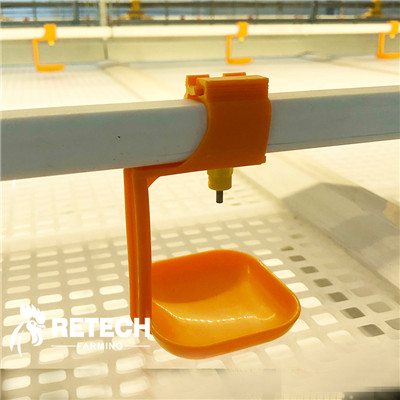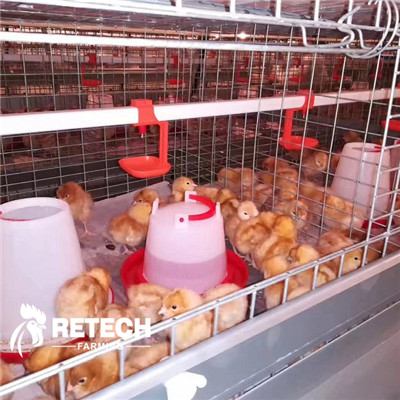1. Sicrhewch gyflenwad dŵr digonol ar gyfer ieir dodwy.
Mae cyw iâr yn yfed tua dwywaith cymaint o ddŵr ag y mae'n ei fwyta, a bydd yn uwch yn yr haf.
Mae gan ieir ddau uchafbwynt dŵr yfed bob dydd, sef 10:00-11:00 yn y bore ar ôl dodwy wyau a 0.5-1 awr cyn diffodd y goleuadau.
Felly, dylai ein holl waith rheoli amrywio yn ystod y cyfnod hwn a pheidio byth ag ymyrryd â dŵr yfed yr ieir.
| Cymhareb y cymeriant bwyd a'r cymeriant dŵr ar wahanol dymheredd amgylchynol | Symptomau dadhydradiad | ||
| Tymheredd amgylchynol | Cyfran (1): X) | Arwyddion rhannau o'r corff | Ymddygiad |
| 60oF (16℃) | 1.8 | Coronau a wattlau | atroffi a cyanosis |
| 70oF (21℃) | 2 | cyhyrau’r pen ôl | chwydd |
| 80oF (27℃) | 2.8 | stôl | rhydd, pylu |
| 90°F (32°C) | 4.9 | pwysau | dirywiad cyflym |
| 100oF (38℃) | 8.4 | cyhyrau'r frest | ar goll |
2. Bwydwch ddŵr yn y nos i leihau sgwrio marw.
Er bod dŵr yfed yr ieir wedi dod i ben ar ôl i'r goleuadau gael eu diffodd yn yr haf, ni stopiodd ysgarthu dŵr.
Mae ysgarthiad a gwasgariad gwres y corff yn achosi colli llawer iawn o ddŵr yn y corff ac effeithiau negyddol lluosog o dymheredd uchel yn yr amgylchedd, gan arwain at gludedd gwaed, pwysedd gwaed a thymheredd y corff.
Felly, gan ddechrau o'r cyfnod pan fydd y tymheredd cyfartalog yn uwch na 25°C, trowch y goleuadau ymlaen am 1 i 1.5 awr tua 4 awr ar ôl i'r goleuadau gael eu diffodd yn y nos (peidiwch â chyfrif y goleuadau, mae'r rhaglen oleuadau wreiddiol yn parhau i fod heb ei newid).
Ac mae pobl eisiau mynd i mewn i'r cwt ieir, rhoi'r dŵr ar ddiwedd y llinell ddŵr am ychydig, aros i dymheredd y dŵr oeri, ac yna ei gau.
Mae troi'r goleuadau ymlaen yn y nos i adael i'r ieir yfed dŵr a bwydo yn fesur effeithiol i wneud iawn am y prinder cymeriant bwyd a dŵr yfed yn ystod y dydd poeth a lleihau nifer yr achosion o farwolaeth.
3. Mae'n bwysig cadw'r dŵr yn oer ac yn lân.
Yn yr haf, pan fydd tymheredd y dŵr yn uwch na 30°C, nid yw ieir yn fodlon yfed dŵr, ac mae ffenomenon ieir gorboethi yn hawdd digwydd.
Cadw'r dŵr yfed yn oer ac yn hylan yn yr haf yw'r allwedd i iechyd yr haid a pherfformiad cynhyrchu wyau da.
Er mwyn cadw'r dŵr yn oer, argymhellir rhoi'r tanc dŵr ar y llen wlyb, ac adeiladu cysgod neu ei gladdu o dan y ddaear;
Monitro ansawdd y dŵr yn rheolaidd, glanhewch y bibell ddŵr bob wythnos, a glanhewch y tanc dŵr bob hanner mis (defnyddiwch lanedydd arbennig neu ddiheintydd halen amoniwm cwaternaidd).
4. Sicrhewch allbwn dŵr teth digonol.
Mae ieir sydd â digon o ddŵr yfed wedi gwella ymwrthedd i straen gwres ac wedi lleihau marwolaethau yn yr haf.
Ni ddylai allbwn dŵr teth y cawell math-A ar gyfer ieir dodwy fod yn llai na 90 ml/munud, yn ddelfrydol 100 ml/munud yn yr haf;
Gellir lleihau cewyll math-H yn briodol o ystyried problemau fel carthion tenau.
Mae allbwn dŵr tethau yn gysylltiedig ag ansawdd y tethau, pwysedd dŵr a glendid y llinell ddŵr.
5. Gwiriwch y tethau’n aml i atal blocâdau a gollyngiadau.
Mae mwy o ddeunydd ar ôl yn y safle lle mae'r deth wedi'i blocio, ac mae'r amser ychydig yn hirach i effeithio ar gynhyrchu wyau.
Felly, yn ogystal ag archwiliadau mynych ac eithrio digwyddiad blocâd tethau, mae angen lleihau gweinyddiaeth dŵr yfed cymaint â phosibl.
Yn y tymor tymheredd uchel, mae'r porthiant ar ôl i'r deth ollwng a gwlychu yn dueddol iawn o lwydni a dirywiad, a bydd yr ieir yn dioddef o glefyd ac yn cynyddu'r gyfradd marwolaeth ar ôl bwyta.
Felly, mae angen gwirio a disodli'r deth sy'n gollwng yn rheolaidd, a chael gwared ar y porthiant gwlyb mewn pryd, yn enwedig y porthiant llwyd o dan y rhyngwyneb a'r cafn offer.
Amser postio: Gorff-13-2022










